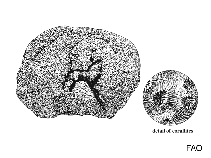Diploria labyrinthiformis (Linnaeus, 1758)
Grooved brain coral| Native range | All suitable habitat | Point map | Year 2050 |

|
| This map was computer-generated and has not yet been reviewed. |
| Diploria labyrinthiformis AquaMaps Data sources: GBIF OBIS |
Изображение на Google | No image available for this species;
drawing shows typical species in Faviidae.
Классификация / Names народные названия | синонимы | CoL | ITIS | WoRMS
Hexacorallia | Scleractinia | Faviidae
Environment: milieu / climate zone / пределы глубины / distribution range экология
ассоциированный с рифами; пределы глубины 0 - 45 m (ссылка 83917). Subtropical; 33°N - 8°N, 92°W - 58°W (ссылка 848)
Distribution страны | регионы FAO | Ecosystems | места находок | интродукции
Western Atlantic.
Length at first maturity / Size / Weight / Возраст
половая зрелость: Lm ? range ? - ? cm
Краткое описание морфология
Life cycle and mating behavior половая зрелость | размножение | нерест | Eggs | Fecundity | Larvae
Основная ссылка
ссылки | координатор | соавторы
Collin, R., M.C. Díaz, J. Norenburg, R.M. Rocha, J.A. Sánchez, M. Schulze, A. Schwartz and A. Valdés 2005 Photographic identification guide to some common marine invertebrates of Bocas Del Toro, Panama. Caribbean Journal of Science. 41(3):638-707. (ссылка 415)
Статус Красного Списка МСОП
(ссылка 130435: Version 2025-1)
Статус СИТЕС (ссылка 108899)
CMS (ссылка 116361)
Угроза для людей
Использование человеком
| FishSource |
инструменты
дополнительная информация
Max. ages / sizes
Length-weight rel.
Length-length rel.
Размерный состав
Mass conversion
численность
ресурсы в Интернет
BHL | BOLD Systems | CISTI | DiscoverLife | FAO(Publication : search) | Fishipedia | GenBank (Геном, Нуклеотид) | GloBI | Gomexsi | Google Books | Google Scholar | Google | PubMed | Tree of Life | Wikipedia (Вперёд, поиск) | Zoological Record



